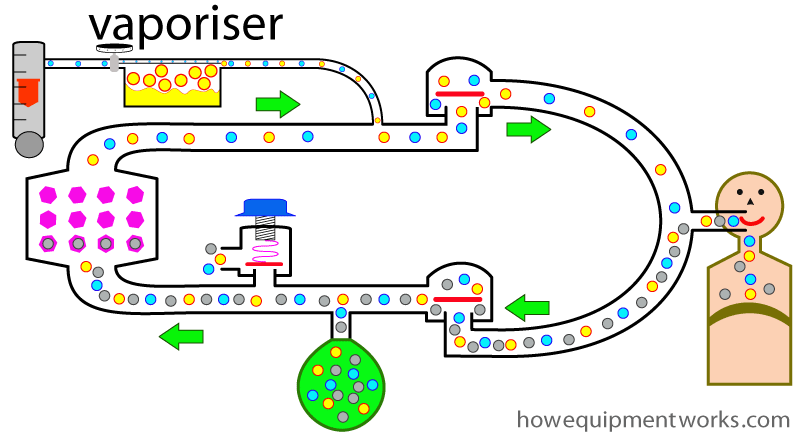Breathing Systems
Bailey Freeman, DNP, CRNA and Angela Mordecai, DNP, CRNA
What Is a Breathing Circuit?
A breathing circuit is the system that connects the anesthesia machine to the patient. It delivers oxygen and anesthetic gases, and removes exhaled carbon dioxide (CO₂). You can think of it like a loop of roads: gases go in, flow through the patient, and exit the system—or get filtered and reused.

How Does It Work?
Fresh gas enters the circuit from the machine. The patient inhales this mixture through one limb of the circuit. Exhaled gases then leave through a second limb. Some systems remove exhaled CO₂ and reuse the gas; others discard it entirely. The process is supported by valves, absorbers, and pressure control mechanisms.
What Are the Main Types?
- Rebreathing (Circle) System: Common in most OR settings. Filters and reuses exhaled gas after removing CO₂. Includes a CO₂ absorber, reservoir bag, and APL valve.
- Non-Rebreathing System: Discards all exhaled gas and replaces it with fresh flow. Typically used in short cases or for small patients due to simplicity and low resistance.
How Do I Set It Up?
- Connect the breathing circuit securely to the anesthesia machine.
- Check that all parts are clean, leak-free, and assembled properly.
- Select a fresh gas flow appropriate for the circuit type and patient.
- Always perform a machine and circuit check before use.
- You will learn how to do your HIGH PRESSURE CHECK to check the integrity of your circuit during your anesthesia machine check/SAMMTIDE.
- Monitor pressures, gas flow, and patient ventilation during the case.
- After the case, dispose or disinfect components per your facility’s protocol.
What Should I Check Before Use?
- Leak test (HIGH PRESSURE CHECK): Turn off any O2 or air flow (failing to turn it off can mask a leak in the system by replacing air faster than it is leaking out), Close your APL Valve, Inflate the circuit and ensure it holds pressure.
- CO₂ absorber: Check for color change or time since last replacement.
- APL valve: Confirm it opens, closes, and holds pressure as expected (see above).
How Do I Confirm It’s Working?
- Watch for the reservoir bag to rise and fall with each breath.
- Check for a consistent ETCO₂ waveform and stable oxygen saturation.
- Ensure the scavenging system is properly removing waste gases.
Scope Guide
Strategies
- Choose the right circuit based on patient size, surgical duration, and ventilation needs.
- Use diagrams or animations to show gas flow paths—especially in circle systems.
- Explain tradeoffs: rebreathing conserves gases and moisture; non-rebreathing is simpler but less efficient.
Clinical Optimization
- Watch for rising airway pressures (may signal a kink, water buildup, or obstruction).
- Replace the CO₂ absorber when it’s exhausted—watch for a rising ETCO₂ trend.
- Use low-flow anesthesia with rebreathing systems to conserve volatile agents.
Pearls
- Non-rebreathing circuits are ideal for quick cases and pediatric patients.
- Always double-check APL valve settings before induction.
- Do a full circuit check every time—even if the setup looks simple.
References
- StatPearls. Anesthesia Breathing Systems. NCBI Bookshelf. https://www.ncbi.nlm.nih.gov/books/NBK574503/
- OpenAnesthesia. Anesthesia Breathing Systems. https://www.openanesthesia.org/keywords/anesthesia-breathing-systems/
- How Equipment Works. Circle Breathing System. https://www.howequipmentworks.com/circle_breathing_system/. Accessed August 5, 2025.
Media Attributions
- vaporiser_label

